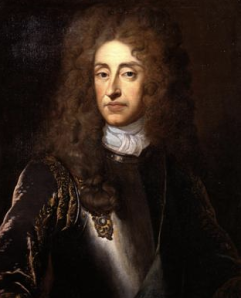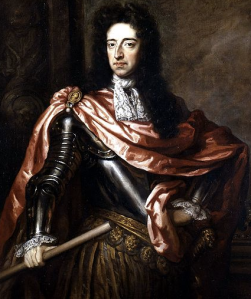Since we’ve been hearing about the planned Captain Blood remake since July, 2009, I thought it about time to revisit the 1935 version. It’s unclear when the Spierig brother‘s science fiction adaptation will be released, or if it’s in pre-production. Warner Bros. and producer Bill Gerber have said the story – lifted from Rafael Sabatini’s novel – will remain unchanged, even if the characters will be fighting across galaxies and not in 17th century galleons.
The Captain Blood that has endured as a classic was actually a remake of a 1924 silent film starring J. Warren Kerrigan, who left acting after this film. Some shots of the naval battle were edited into Flynn’s sound update.
The Talent
Producers Hal B. Wallis and Jack Warner hired Michael Curtiz, and old hand at Warner, to direct the big-budget swashbuckler. The Hungarian-born Curtiz had moved to the United States in 1926, though his English remained so poor he often called his estranged wife Bess Meredyth for linguistic help on set. [Harmetz, Alean. Round Up the Usual Suspects: The Making of “Casablanca”. Orion Publishing Co, 1993. p. 123] Though he was a versatile talent he always inflicted a sense of action in a scene, moving the camera, playing with shadow, adding a shifting European dynamism.

Jack L. Warner and Hal B. Wallis plan Blood. Curtiz looks on. From: http://www.eightyoddyears.com/gallery-103.html
Captain Blood was the first of eight collaborations between Curtiz and Tasmanian actor Errol Flynn, who worked for Warner Bros. England in the early 1930s. He was, however, unknown on the other side of the Atlantic. Olivia de Haviland was also unknown, playing parts in A Midsummer Night’s Dream (1935) and The Irish in Us (1935 – and what a title). This was an almost unprecedented risk for a tentpole picture.
Warner was gambling on the recent successes of The Count of Monte Cristo and Treasure Island (both 1934). The period piece allowed studios to bend the rules of the Hollywood Code, enforced energetically due to pressure from groups like the Catholic National Legion of Decency. Historical settings allowed more leeway for violence, drunkenness, and sexual innuendo – how can you shoot a pirate movie and not show brawling, alcoholism, and womanizing? Warner felt the time was right to reinvigorate the genre. He made some predictable casting decisions, too, just to be safe: Basil Rathbone was an easy pick for the likeable villain Lavasseur, and Lionel Atwill was a reliable bad guy, whose every gesture and sharp glare lets you know he’s mean without the trouble of much establishing dialogue.
According to film scholar and biographer Lincoln D. Hurst, Flynn was quaking with fear in the early days of the shoot. This is not apparent in the final product partly because Curtiz reshot some of those moments after Flynn gained the charisma and confidence that seduced audiences. Thomas McNulty, author of Errol Flynn: The Life and Career, calls the star a “personality” actor, not a “method” actor of the Stanislavski school: “He had style when style was everything.” Evaluating Flynn as a good or bad actor is almost besides the point. He matched the glowing pomp of the Hollywood Golden Age.
Despite the scope of the pirate battles, Warner and Wallis relied almost exclusively on soundstages. The Rathbone-Flynn duel was filmed at Laguna Beach under the supervision of fencing master Frank Cavens. He gave Hollywood sword fights a polished elegance, and was probably held in the same high regard Woo-ping Yuen of The Matrix and Crouching Tiger, Hidden Dragon is today.
The original music was supplied by Austrian composer Erich Korngold. He had just returned to Europe from scoring A Midsummer Night’s Dream when he was asked to score Captain Blood…in three weeks. Because of ominous sounds from Germany, Korngold decided to remain in L.A., scoring Warner’s films until 1947. In Captain Blood he hammered home emotional themes through operatic crescendos, drumming in the upswings and downswings of the plot. His flourishes underscore Blood’s motivations and desires, a perfectly thunderous accompaniment to a full-throttle action movie:
[http://www.youtube.com/watch?v=hAMMgOtxISo]
The film’s overwhelming success was one of the most stunning debuts of any Hollywood actor. And the debut of a stunning couple: de Havilland and Flynn became a star team. I will look at a few of their others collaborations, including They Died With Their Boots On (1941) and The Private Lives of Elizabeth and Essex (1939) in the new few weeks. Warner’s casting instincts proved right, and all of the film’s uncertain elements coalesced and connected with audiences. Something similar would happen in 1942, when Curtiz directed Humphrey Bogart and Ingrid Bergman in an oddly structured film called Casablanca.
The English Revolution
Warner wisely stayed away from the political content of the period, which was in any case an odd scenario for a modern pirate movie. Pirates of the Caribbean remained in safe waters by pitting the British Royal Navy and a rabble lovable pirates against unlovable pirates. Peter Blood, on the other hand, is a Protestant rebel in an England on the brink of another civil war. The year is 1685, the Catholic James II has just ascended the throne, and the Duke of Monmouth’s rebellion has just been defeated.
Peter Blood, a physician of Monmouth’s supporters, is sentenced to slavery in Bardbados by no other than Judge Jeffreys, a notorious alcoholic and royalist. Some rebels actually did become plantation slaves, though Curtiz does not portray the misery of the black slaves in the colony who vastly outnumbered the band of English dissenters. The film also avoids religious references; apart from the word “papist” in the opening scenes, the struggle is cast in mould of tyranny vs. freedom, not Rome/France vs. the Anglican Church (and the other strands of Protestantism).
The Glorious Revolution itself happens offscreen. While Blood captures a Spanish galleon, pirates all over the Caribbean,
duels Levasseur over the governor’s daughter, and saves Barbados from the French navy, William of Orange invaded England with a Dutch navy. William was married to James’ daughter Anne. The King’s support collapsed when William came ashore and ascended to the throne as join-ruler with his wife. The Bill of Rights were passed, cementing Parliament’s ascendancy in financial matters, essentially keeping England on the course of constitutional monarchy.
In the film Blood is summoned back by the new King. He gladly throws down his pirate ways just as he seems most determined to stay an outlaw. Protestant William’s summons is an odd mixture of deus ex machina and historical accuracy – though I am not sure if the rebels were pardoned by William. Monmouth, after all, held several coronation ceremonies in Somerset county, treasonous behaviour since James II was a legitimate monarch.



